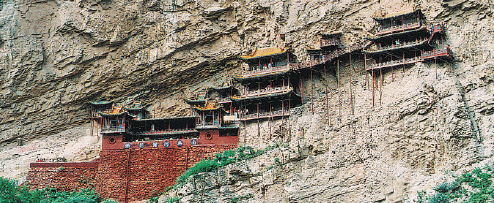Xuankong Temple a breathtaking architectural wonder of ancient times

Xuankong Temple, built in the Northern Wei Dynasty (386-534), is a prime example of engineering achievements in ancient China. [Photo by Liu Yujun for China Daily]
Cultural experts claim Shanxi is home to the largest number of ancient buildings in China. Xuankong Temple at Hengshan Mountain in Hunyuan county is no doubt one of the most remarkable examples of such a claim.
Constructed of wood, tiles and stones during the mid-Northern Wei Dynasty (386-534), the temple is made up of two three-story pavilions and a yard linked by staircases and steps. The staircases and steps are lined along the surface of a sheer cliff rising 50 meters above a stream at the foot of the mountain.
Seen from below, Xuankong Temple, which literally means "temple hanging in the sky", appears extremely precarious. It is supported only by a few thin stanchions standing on protruding rocks. For that reason, it was selected by Time magazine as one of the 10 most dangerous buildings in the world in 2010.
Sun Shupeng, chief engineer at Shanxi Ancient Architecture Group, however, refuted the notion that Xuankong Temple is, in fact, a dangerous structure.
"The temple has been standing firmly on the Hengshan cliff for more than 1,500 years and is still kept intact and solid," Sun said. "A study of the temple is an exploration of an ancient Chinese engineering miracle."
Sun said the stanchions were only added relatively recently as a psychological comfort to visitors. The dozens of thick square beams made from hemlock wood sustain most of the building's weight.
A number of large, deep holes were dug into the cliff's surface, and two-thirds of the length of the beams together with wedges were driven into each one.
Sun said there are other explanations as to why the temple has remained intact for more than 1,500 years.
Other than its sturdy construction, local people have found that the section of cliff above the temple acts like an umbrella to shield the complex from rain and sunlight. In summer, when the daytime is the longest, the temple only receives about two hours of direct sunlight a day during the morning.
The narrow valley it faces also changes the direction of airflow. The wind usually blows toward the cliff facing the temple, but rarely reaches the temple.
The temple is worshipped by believers of Buddhism, Taoism and Confucianism.
There are more than 80 statutes of the three religions in the temple, showing how the North Wei Dynasty allowed the coexistence of different religions.
The temple boasts many carved beams and painted rafters which tell stories and legends of the three different religions.
Li Yali contributed to this story.



